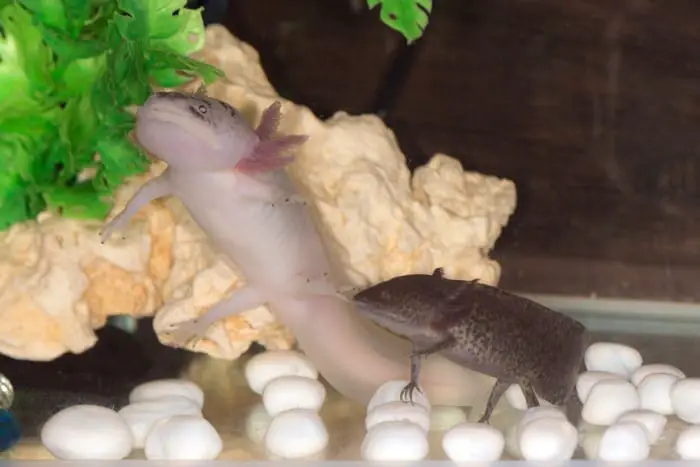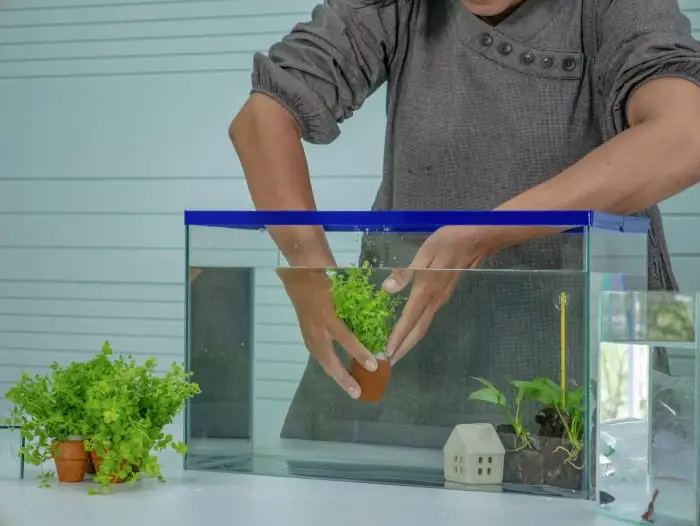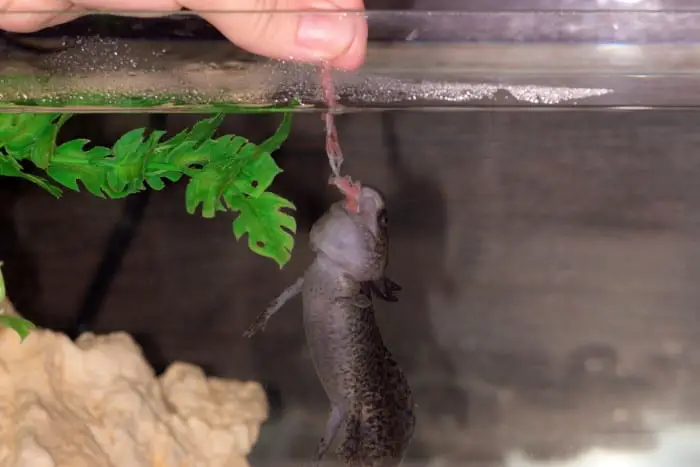Understanding Axolotl care is a question that often arises when new aquarists lay eyes on these unusual amphibians for the first time. With their prehistoric appearance and charming expressions, Axolotls are great first amphibians that are in many ways a blend of the herpetology and aquarium worlds!
The Axolotl At a Glance
Let’s take a look at some of the things that make Axolotls such an interesting animal.
Origin of the Axolotl
Axolotls are a biological and conservation curiosity because as common as they are in captivity they are threatened with extinction in the wild. They are found only in the canals of former Lake Xochimilco, which was part of a series of lakes that have mostly been subsumed by Mexico City.

As Mexico City (formerly the Mexican capital of Tenochtitlan) grew over the centuries Lake Xochimilco and the others were drained to control flooding and create new places for urban development.
Axolotls are found only in this part of the world and nowhere else, making them an endemic species. While they have become something of a national symbol (including an official emoji of Mexico City) there are estimated to only be a few thousand left in nature.
Axolotl Biology
They are as fascinating to scientists as they are to aquarists because they have several unusual traits. For one, their ability to regenerate lost limbs and even organs is highly unusual for vertebrates.
Also, the reason Axolotls look so strange is that they are a natural example of neoteny. Which, simply explained, means they never grow up!
Like all amphibians, Axolotls have an aquatic juvenile phase. But unlike any other amphibian, they never grow out of it – instead, they mature into an adult-sized larval form capable of breeding.
Axolotls can reach up to 18 inches in length, with 8 to 12 inches being more common captivity. And with a lifespan of up to 15 years when well cared for, Axolotls are a perfect pet for hobbyists looking for something unusual in appearance!
Axolotl Behavior
Cold-blooded creatures from a cold environment, Axolotls are by nature somewhat sluggish. They crawl along the bottom in slow motion hunting for moving prey to vacuum up in their broad mouths. Despite this, they will occasionally swim around explore their environment.
While Axolotls aren’t very social they can be kept together. Juveniles tend to nip at anything moving, including the limbs and fins of other Axolotls. However, adults will rarely bother one another.
Handling Axolotls
Given their cuddly expressions and slow movement it’s tempting to want to pick up an Axolotl. However, you should avoid handling them except when absolutely necessary.
Like all amphibians, they have a mucus layer that protects their sensitive, extremely thin skin from infections and abrasions. While wetting your hands first helps your skin is far rougher and will strip some of this slime away, exposing their skin to potential injury.
The oils in our skin are also potentially problematic to them – and the skin secretions of many amphibians are irritating or even poisonous as a defensive measure against predators. It’s best to leave your Axolotl in the water at all times.
Tank Mates for Axolotls
While not aggressive they are opportunistic eaters, which means one has to choose their tank mates with some care. Axolotls are best kept either alone or with other Axolotls. Their fleshy, waving gills are too tempting a target for most fish.

Small fish like livebearers and tetras will eventually end up as a meal. Large, peaceful coldwater fish like Goldfish are ideal tank mates that get big enough not to be eaten.
However, they will suffer bites on occasion as they wander too close to the Axolotl and can lose chunks of fins and scales in the process. Goldfish will also greedily devour any pellets and dead food you try to offer to your Axolotls.
Shrimp, snails, and other aquatic invertebrates can work with young Axolotls but will also eventually be eaten as the salamander matures. Axolotls really should be kept in species tanks or by themselves.
Axolotl Habitat Needs
Before you actually go out and buy an axolotl make sure you do your research and get everything you will need. This includes the aquarium, filter, decor, substrate and water conditioners.
Choosing an Aquarium
While fairly large Axolotls aren’t too active and don’t need as much space as you might think. As a rule of thumb, each adult Axolotl should have 10 gallons of space each.
However, I recommend erring on the side of caution and keeping a full-grown adult at least a 20-gallon long aquarium. An adult Axolotl creates a lot of waste and the extra water volume (along with a powerful hang on the back or canister filter) will help keep ammonia and other toxic compounds from building to toxic levels too quickly.
When choosing lighting for your Axolotl tank aim for a subdued atmosphere. In nature, they are found in weed-choked waters with relatively little light. Their eyes do work but are lidless and need protection from harsh illumination.
Decorating an Aquarium

Driftwood, rocks and live or plastic plants go a long way in helping them feel comfortable. The more safe spaces they have the more likely they are to come out into the open.
Even as adults they are gentle on live plants and can coexist with established aquascapes so long as your plants can tolerate the water conditions Axolotls need to thrive.
Axolotls should only be kept on sand substrates; never gravel or bare-bottomed aquaria.
They don’t swim particularly well and do need a bit of grip when walking. And their method of feeding, essentially vacuuming up prey in a rapid sucking motion, often brings in detritus from the environment.
If they happen to swallow gravel along with their food it can get lodged in their intestines, blocking them and eventually killing the Axolotl. However sand will pass through with no issues!
Axolotl Water Conditions
As coldwater mountain lake creatures, Axolotls need specific conditions to thrive in. They can be kept in newly set up as well as cycled aquariums but not in conditions suitable for most tropical fish.
While they aren’t challenging conditions to maintain, keeping them in improper environments is the leading cause of death for captive Axolotls.
Ideal water conditions are as follows:
- Temperature: 60-68°F
- pH: 7.0-8.0
- Hardness levels: moderate to high
- Oxygenation: high to very high
Room temperature water is perfect for much of the world. Temperatures above 68°F cause stress as it accelerates their metabolisms and fosters the growth of bacteria.
Warm water also holds less oxygen compared to cold water. Oxygen levels need to be high because Axolotls breathe not only using their gills but also their skin (they also breathe using their throats and separate lungs as well)!
While filters provide some helpful surface agitation, live plants and aeration stones help keep oxygen levels high for Axolotls. These are preferred because Axolotls come from a shallow alpine lake and are poor swimmers: strong currents should be avoided as much as possible.
And given their carnivorous nature and large adult size, they create copious amounts of waste, making frequent water changes essential to good health. Unclean water will lead to gill and skin infections as well as reduced feeding responses.
While you don’t need to heat the water before adding it to your Axolotl aquarium you do need to condition it first. Municipal water treatment plants add chlorine and chloramine to tap water to kill off any remaining traces of bacteria and viruses harmful to public health.
Since both of these chemicals are toxic to Axolotls dechlorinators available at any pet supply store instantly purge water of chlorine and chloramine.
I also recommend adding a touch of Aquarium Salt (~ 1 tablespoon per 5 to 10 gallons). Ocean sourced aquarium salts contain calcium, magnesium, and other trace elements that help them thrive. Traces of salt also bolsters immunity and improves gill function in all aquatic animals!
Axolotl Food Requirements

As natural predators Axolotls prefer small live prey items for food. Feeder fish, live ghost shrimp, earthworms, crickets, mealworms, and other standard pet store live foods will all satisfy them.
They can also be trained to accept dead items (frozen brine shrimp cubes, slices of raw meat, etc) and even prepared foods like salamanders and fish pellets but not always. They are so motion-sensitive that they may not recognize pellets as food.
Flakes and small pellets should not be offered. They will only be ignored and will foul the water as they rot.
Any dead or prepared foods should first be soaked before offering to your Axolotl and actively picked up and wiggled in front of them to encourage a feeding response!
Health Problems
While generally hardy when kept in the right conditions Axolotls are prone to a few issues.
Poor Water Quality
Since they create so much waste ammonia, nitrite and nitrate can reach toxic levels quickly, especially when keeping them in smaller aquariums. Poor water quality also increases the chance of skin infections taking hold (see below).
Remember to also keep temperatures on the cool side for Axolotls (60-68°F) and conditions neutral to alkaline in chemistry. Acidic conditions increase the toxicity of ammonia and other waste products.
Lastly, low oxygenation can lead to reduced appetite and opening a route for infections. Axolotls have lungs for breathing air but preferentially breathe using their gills and skin so oxygen levels should be as high as possible.
Skin Infections
As I mentioned earlier, Axolotls have thin, sensitive skin like all amphibians. Their skin is the first thing you should examine when looking to buy a new Axolotl because this is where most infections begin.
Bacterial infections often manifest as inflamed red blood vessels that eventually grow into red sores. This can be difficult to diagnose in albino Axolotls since they are naturally pale. But take the time to compare them with other Axolotls in the tank; patches of red sores are clear cases of bacterial infections.
Fungal infections show up as cottony growths and usually follow injuries like bites or abrasions from sharp gravel or rocks. Gills bitten by tank mates can also get infected by fungus.
Usually, fungal and bacterial diseases are caused by a combination of open wounds and poor water quality, especially when kept in groups in heated tropical tanks.
Skin infections can be difficult to treat because their sensitive skin means they can absorb too much medication, potentially poisoning them. However half doses may not be enough to kill off the infectious agent. Prevention is the best cure for any Axolotl disease!
Final Thoughts on Axolotl Care
Unique as they are I think any aquarist looking to try keeping an Axolotl has little to worry about! Simply keep them cold and clean, while offering them live (or dead but wiggling) food and you’ll have a guaranteed conversation starter for years to come!
Plus keeping them in captivity keeps the genetic line diverse and helps conservationists ensure they will be successfully reintroduced into their home lakes one day! Good luck doing your part preserving Axolotls for future generations to enjoy!

